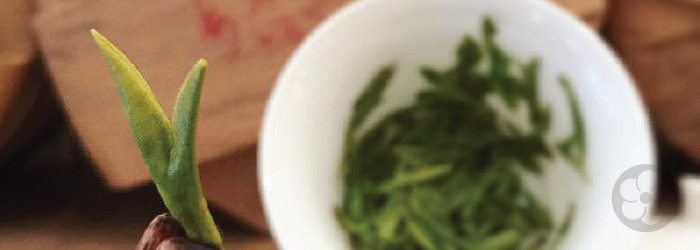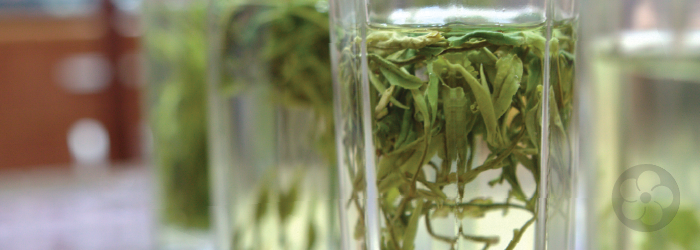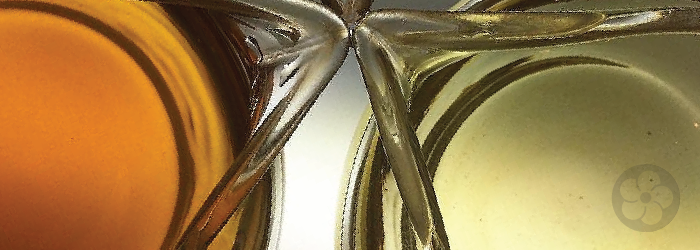Each variable in the brewing process can impact the flavor of the finished cup. This quick reference guide will help you get the most out of your tea, but no two tea drinkers are alike. Keep reading to find out how to adjust for the perfect brew.
Tea Leaves
The most important factor in brewing a good cup of tea is to start with quality leaves.
Mass produced bagged teas contain chopped leaves or "fannings". These broken bits sacrifice quality of flavor for a larger quantity. Small pieces of tea leaves will be more likely to create bitterness and astringency in the cup.
In contrast, high quality, whole leaf teas are forgiving to brew. They are much less likely to produce unpleasant flavors.
Once you've selected a tea, the next consideration is how much to use. The ratio of leaves to water determines the strength of the brew.
In traditional Chinese gong fu cha, a large serving of leaves brews in a very small teapot. This creates a small, concentrated cup, much like an espresso. For a western style brew, fewer leaves are used in a larger brewing vessel. This reduces bitterness when the leaves stay in the water for a long period of time.
Teas can vary a lot in volume depending on how they were processed, so it is helpful to weigh the leaves. This will ensure an accurate quantity.
Water
The temperature of the water used to brew the tea leaves can have a dramatic impact on the final flavor.
In general, teas with less oxidation, like green or white teas, are best brewed at a low temperature. This avoids drawing out hydrogen sulfides that create “overcooked vegetable” flavors.
Teas that are heavily oxidized, like roasted oolongs and black teas, need water that is near a full boil. The higher temperatures help “wake up” the leaves from their shelf-stable dried state.
The quality of the water itself can have an effect on the flavor of the tea as well. This seems obvious, since the beverage is, in fact, 98% percent water, but is often overlooked.
Water that is very hard or very soft can change the character of a tea. Sometimes, the effect is so dramatic that it overwhelms the tea’s natural flavor profile. Filtered water or fresh spring water can help to clarify those flavor notes. But in some cases, mineral content of the water can enhance the tea's natural character, as well.
Steeping Time
Finally, the easiest variable to control is the amount of time the leaves steep in the hot water.
Many tea drinkers know that steeping tea leaves for too long can produce bitterness in the brew. But this variable can be adjusted to compensate for a lack of precision in other areas.
For instance, if the water is hotter than desired, a shorter steep can reduce bitterness. On the other hand, leaves in cooler water can steep longer to draw out fuller flavors.
Depending on the tea, the recommended steeping time can vary quite a bit. We recommend no more than two or three minutes for any of our teas, to allow for many infusions of the same leaves.
Any whole leaf tea should deliver a stronger and more complex flavor on its second and third brew. In fact, this is the best way to check the quality of any tea leaves. Chopped leaves or teas with artificial flavorings lose flavor after the first infusion.
Brewing Vessels
Our main three considerations are the most important to keep in mind. But the material of the brewing vessel can also affect the flavor of the finished tea.
If you brew a variety of different teas, we recommend nonporous glass or glazed ceramics. These flavor-neutral vessels are also best for testing quality.
Connoisseurs often choose a unglazed Yixing clay teapot to dedicate to one category of tea. Over time, the unglazed clay will gradually absorb tea oils. After many years of use, the teapot will enhance the flavor of the selected style.
Generally, metal or plastic brewing vessels are best avoided.They can add their own flavors to the brew, as well as take on flavors of strong teas. These inconsistencies can change and overwhelm subtle flavors.
Today, enameled cast iron pots are popular among modern tea drinkers. But according to tradition, these heavy vessels are only for boiling water and keeping it hot. In fact, their incredible heat retention can often over brew delicate tea leaves. Cast iron or heavy ceramic is best reserved for darker style teas. White and green teas brew better in glass or porcelain.
Additives
Finally, we know many tea drinkers like to add milk or sweetener to their teas. There’s nothing wrong with that!
Many western style teas are bold black teas grown in sunny climes. With more sun exposure, comes more bitterness and acidity in the leaf. In this context, adding milk and sugar is utterly understandable.
But we choose our artisanal teas for their delightful flavors without additives. To us, adding milk or sugar to these teas is much like making sangria from a good bottle of wine - it’s a bit of a waste.
We always recommend sipping your tea without additives first! There is no better way to experience the true depth of flavor it offers.






